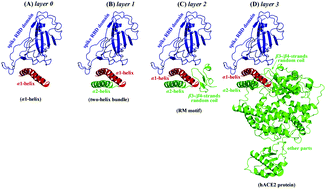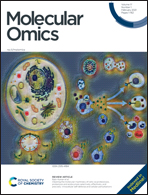Context contribution to the intermolecular recognition of human ACE2-derived peptides by SARS-CoV-2 spike protein: implications for improving the peptide affinity but not altering the peptide specificity by optimizing indirect readout†
Abstract
Severe acute respiratory syndrome coronavirus 2 (SARS-CoV-2) is an etiological agent of the current rapidly growing outbreak of coronavirus disease (COVID-19), which is straining health systems around the world. Disrupting the intermolecular association of SARS-CoV-2 spike glycoprotein (S protein) with its cell surface receptor human angiotensin-converting enzyme 2 (hACE2) has been recognized as a promising therapeutic strategy against COVID-19. The association is a typical peptide-mediated interaction, where the hACE adopts an α1-helix, which can form a two-helix bundle with the α2-helix, to pack against a flat pocket on the S protein surface. Here, we demonstrate that the protein context of full-length hACE plays an essential role in supporting the hACE2 α1-helix recognition by viral S protein. Energetic analysis reveals that the α1-helical peptide (αHP) and also the two-helix bundle peptide (tBP) cannot bind effectively to S protein when they are split from the hACE protein. The context contributes moderately and considerably to the direct readout (DR) and indirect readout (IR) of peptide recognition, respectively. Dynamics simulation suggests that the two free peptides exhibit a large intrinsic disorder without the support of protein context, which would incur a considerable entropy penalty upon binding to S protein. To restore the IR effect lost by splitting peptides from hACE, we herein propose employing hydrocarbon stapling and cyclization strategies to constrain the free αHP and tBP peptides into their native ordered conformations, respectively. The stapling and cyclization are carefully designed in order to avoid influencing the peptide DR effect, which has been demonstrated to improve the peptide binding affinity (but not specificity) to S protein. The stapling/cyclization-imposed conformational constraint can effectively minimize the unfavorable IR effect (i) by reducing the peptide flexibility and entropy cost upon their binding to S protein, and (ii) by helping peptide pre-folding into their native state to facilitate the conformational selection by S protein.

- This article is part of the themed collection: Coronavirus articles - free to access collection


 Please wait while we load your content...
Please wait while we load your content...